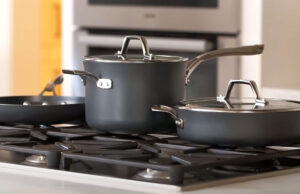As an Amazon Associate, I earn from qualifying purchases at no extra cost to you.
How to Install Samsung Dishwasher Easily Without Hassle
You just bought a shiny new Samsung dishwasher, and your sink is still piled with dishes. The thought of installing it yourself feels overwhelming, right? In this article, we’re going to tackle that stress head-on. Imagine sliding that sleek appliance into your kitchen and hearing it hum perfectly—sounds satisfying! Let’s make it happen, step by step, without any headaches or confusion.
Prepare Your Kitchen and Dishwasher Space
Before touching the dishwasher, clear the area completely. Remove any old appliances carefully, and check that the floor is level. A small tilt can affect performance, so use a level tool to make sure it’s even. Also, measure the cabinet opening to ensure the Samsung dishwasher fits snugly without forcing it.
Next, inspect your plumbing and electrical connections. Make sure the water supply line is nearby and compatible, and check that the drain is accessible. You might need to adjust hoses or install a new connector. Safety is key, so double-check that the power is turned off at the breaker. Preparing thoroughly now prevents future leaks, shorts, or errors.
After preparing the space, gather all dishwasher components and manuals. Having everything in reach keeps the process smooth and stress-free. Look over the installation instructions and make a mental map of the process. A little planning goes a long way in saving time and avoiding mistakes.
- Clear kitchen area completely
- Ensure floor is level
- Measure cabinet space accurately
- Check water and electrical connections
- Gather all components and manuals
Connect Water Supply and Drain Properly
Start by attaching the water supply line to the dishwasher inlet. Use Teflon tape on threads to prevent leaks and tighten the connector with a wrench. Make sure the line isn’t kinked or pinched, which could reduce water flow.
Next, connect the drain hose to the sink drain or garbage disposal. Ensure it forms a high loop to prevent backflow into the dishwasher. Secure all clamps tightly to avoid leaks. Double-check that hoses are not twisted and have room to move slightly, allowing for vibrations during operation.
After connections, inspect all joints and hoses for tightness. Run your fingers along every connection to detect moisture. Once everything looks secure, slowly turn on the water supply and watch for drips. Catching leaks now saves major headaches later.
- Attach water supply line with Teflon tape
- Connect drain hose with a high loop
- Secure all clamps and check for twists
- Inspect all joints for tightness
- Test water flow for leaks
Level and Position Your Dishwasher Correctly
Place the dishwasher into the cabinet opening carefully. Avoid dragging it across the floor, which could damage the appliance or tiles. Slowly slide it in while checking alignment with surrounding cabinets.
Adjust the leveling legs so the dishwasher sits evenly. Use a level tool horizontally and front-to-back to make sure dishes won’t slide or water won’t pool inside. Small adjustments now prevent rattling or poor performance later.
Ensure the front panel aligns with your cabinets for a seamless look. Tighten screws to lock the position, but avoid over-tightening, which could warp panels. Steady and precise placement makes the appliance look professional and function flawlessly.
- Slide dishwasher into place gently
- Adjust leveling legs carefully
- Check horizontal and front-to-back level
- Align front panel with cabinets
- Tighten screws without overdoing
Connect Electrical Power Safely
Before connecting, confirm the power is off at the breaker to avoid shocks. Most Samsung dishwashers use a hardwired connection or a plug-in setup, so check your model requirements carefully.
For hardwired connections, strip wires and attach them to the dishwasher terminals following the color codes: black to black, white to white, and green or bare to ground. Double-check each connection and tighten screws firmly but not overly tight.
For plug-in models, simply plug the dishwasher into a grounded outlet. Ensure cords aren’t stretched or pinched by the appliance. Proper electrical connection ensures your dishwasher runs efficiently and safely without tripping breakers.
- Turn off power at breaker
- Follow hardwired color codes
- Tighten terminal screws correctly
- Use grounded outlet for plug-in
- Avoid stretched or pinched cords
Test the Dishwasher Before Securing
Once water and electrical connections are done, run a short cycle without dishes. Listen for unusual noises or vibrations. Check for leaks around hoses, connections, and the door.
Make adjustments if you notice any issues. Tighten clamps, adjust leveling legs, or reposition hoses as needed. Testing first avoids reinstalling later due to overlooked problems.
After successful testing, secure the dishwasher with mounting brackets to the countertop or side cabinets. This prevents shifting during operation and ensures long-term stability. A little patience now pays off in smooth performance later.
- Run a test cycle
- Listen for unusual noises
- Check for leaks
- Adjust as needed
- Secure with mounting brackets
Finish and Organize the Installation Area
After testing and securing, tidy up the installation area. Remove any tools, packaging, or leftover parts. Wipe down surfaces and check that hoses aren’t pinched.
Store manuals and extra parts nearby for future reference. Double-check that all screws are tight and the appliance door opens smoothly. Taking a few minutes to organize now makes using your dishwasher more enjoyable.
Finally, add any protective trims or panels provided by Samsung. These small touches complete the look and enhance your kitchen’s style. Enjoy your new appliance, knowing it’s installed correctly and safely.
- Clean up installation area
- Store manuals and extra parts
- Check screws and door operation
- Add protective trims or panels
- Enjoy your dishwasher
Final Thoughts
Installing a Samsung dishwasher doesn’t have to be intimidating. With careful preparation, proper connections, and a little patience, your new appliance can run perfectly. Following the steps above ensures safety, reliability, and efficiency. Imagine washing dishes with ease and having more time for yourself. A well-installed dishwasher not only saves time but also adds a professional touch to your kitchen.
| Task | Tips | Tools Needed | Common Issues |
|---|---|---|---|
| Clear space | Remove old appliances carefully | Screwdriver, pliers | Floor unevenness |
| Water connection | Use Teflon tape | Wrench, tape | Leaks, pinched hoses |
| Drain connection | High loop for backflow | Hose clamps | Drips, poor drainage |
| Leveling | Use a level tool | Level, screwdriver | Tilted dishwasher |
| Electrical | Turn off breaker | Wire stripper, screwdriver | Short circuits |
| Test run | Observe cycle | None | Noise, leaks |
Frequently Asked Questions (FAQs)
Is it necessary to turn off water before installation?
Yes, turning off the water supply is crucial. Connecting hoses under live water pressure can cause leaks, flooding, or water damage. By shutting off the main supply, you prevent accidents and make attachment easier. It also gives you time to inspect hoses and fittings without the stress of running water. Safety always comes first, and avoiding water surprises saves cleanup and repair headaches.
Can I install a dishwasher alone?
Absolutely, many people install dishwashers alone. However, having a second person can help lift the appliance safely and hold it steady while adjusting leveling legs. If you’re careful and use proper tools, solo installation is possible. Take your time, follow instructions, and don’t rush the process to ensure a secure and leak-free installation.
Do I need professional tools for installation?
Most household tools are sufficient: screwdrivers, pliers, wrenches, and a level. You don’t need specialized equipment. Teflon tape and hose clamps are often included with the dishwasher. Using these basic tools properly ensures connections are tight, and the appliance functions safely without professional intervention.
Is it safe to connect to a garbage disposal?
Yes, but ensure the disposal is unplugged during installation. The dishwasher drain can connect to the disposal inlet using a provided knockout plug. This prevents backflow and ensures efficient drainage. Follow manufacturer instructions carefully, as improper connection may cause leaks or clogging over time.
Can the dishwasher be installed on uneven floors?
It’s best to level the floor or adjust the leveling legs. Uneven floors can cause the dishwasher to rock, make noise, and affect washing performance. Using a level tool during installation ensures dishes are cleaned properly, and the appliance remains stable during operation.
Do I need to test before final installation?
Yes, always run a short cycle without dishes first. This helps detect leaks, unusual sounds, or improper drainage. Testing before securing ensures adjustments can be made easily. A successful trial run guarantees your dishwasher is ready for everyday use without surprises.
Is it necessary to use Teflon tape?
Yes, Teflon tape on threaded water connections prevents leaks. It creates a tight seal and makes it easier to disconnect if needed later. Skipping it may result in dripping or low water pressure, leading to inefficient washing and potential damage over time.
Can I plug into any outlet?
No, use a grounded outlet as per the dishwasher manual. Avoid extension cords or ungrounded outlets. Proper electrical connection ensures safe operation, prevents short circuits, and reduces fire risk. Always check the voltage requirements of your specific model before plugging in.




